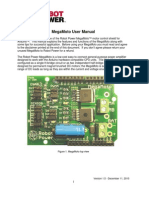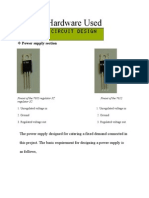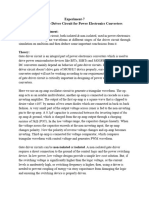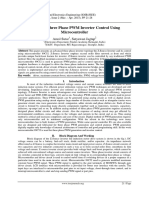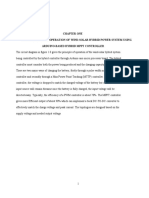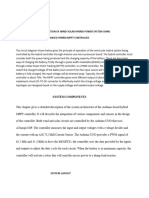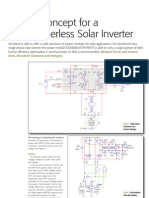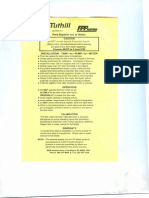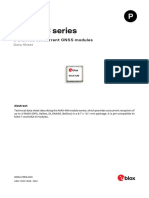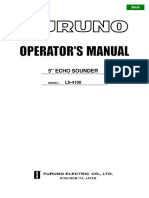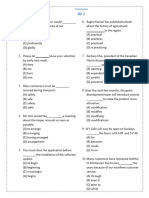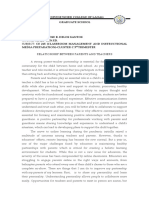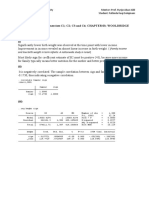MegaMoto Plus Motor Control Shield For Arduino
MegaMoto Plus Motor Control Shield For Arduino
Uploaded by
siogCopyright:
Available Formats
MegaMoto Plus Motor Control Shield For Arduino
MegaMoto Plus Motor Control Shield For Arduino
Uploaded by
siogOriginal Description:
Original Title
Copyright
Available Formats
Share this document
Did you find this document useful?
Is this content inappropriate?
Copyright:
Available Formats
MegaMoto Plus Motor Control Shield For Arduino
MegaMoto Plus Motor Control Shield For Arduino
Uploaded by
siogCopyright:
Available Formats
MegaMoto & MegaMoto Plus User Manual
Thank you for your purchase of the Robot Power MegaMoto™ or MegaMoto Plus motor
control shield for Arduino™. This manual explains the features and functions of the
MegaMoto along with some tips for successful application. Before using your MegaMoto you
must read and agree to the disclaimer printed at the end of this document. If you don’t agree
please return your unused MegaMoto to Robot Power for a refund.
Note, the MegaMoto and MegaMoto plus are electrically identical Heatsinks have been
added to the Plus to increase power handling. All specifications, input-outputs and
instructions (except for current handling) apply to both units.
The Robot Power MegaMoto is a low-cost easy to connect general-purpose power amplifier
designed to work with the Arduino hardware compatible CPU units. The MegaMoto can be
configured as a single H-bridge circuit or as two independent half-bridge circuits. While
designed for permanent magnet brushed DC motors; the MegaMoto is suitable for a wide
range of DC loads as long as they are within the current and voltage envelope of the device.
Figure 1. MegaMoto top view
Version 1.6 - May 28, 2012
1
1. Specifications
Voltage Range 6V – 24V (28V absolute max)
Current (H- 13A cont. at 100% duty cycle
1
bridge) 12A cont. at 70%
30A - 5 second peak
Plus
20A cont. at 100% D.C.
30A with fan
40A peak – 5 seconds
Current (each half- Same as above
bridge)
Current (ganged Double above
half-bridge)
PWM frequency DC – 20kHz
Current Sense Vc = I * 0.075
Output Vc = .0.75 at 10A
Vc = 2.99V at 40A
Input voltage 2.5V – 5.5V = logic high
levels <1.7V = logic low
Size 2.1” x 2.9” x 0.5”
Mounting 3x - 4-40 or M2.5 bolts
1. Your actual current capacity will vary based on the type of load, the length and size of wires, power supply
capability and other factors.
2. Input Output connections and Jumper Settings
Figure 2. MegaMoto connections and jumpers
Version 1.6 - May 28, 2012
2
LED Indicators
The MegaMoto has three LEDs used for visual indication of the state of the unit. The Enable
LED is red and when lit shows that the power chips are enabled. The green PWMA/B LEDs
show the presence of an input signal to the power chips. The brightness of the PWMA/B
LEDs will vary with the duty cycle of the input signal. Note, these LEDs reflect the state of the
inputs to the power chips not the actual output voltage. It is possible for the power chip to be
in safety shutdown while receiving an input signal. Thus it is possible for the LED to be lit
while no voltage is output from the power chips. Note, it is possible and often prudent to code
and debug the Arduino application with no battery connected to the MegaMoto using the LEDs
as visual indicators. The LEDs are powered by the Arduino outputs and do not require a
battery connected to the MegaMoto.
Jumper Connections
The MegaMoto uses jumpers to select which Arduino pins are used for all important functions.
This allows several MegaMoto units to be stacked on one base Arduino unit and be controlled
independently. The MegaMoto also cooperates well with other shields that might have hard-
wired pin assignments.
Enable Jumper: This jumper selects the Arduino pin used to enable and disable the
MegaMoto. There are four choices on this jumper block. One and only one jumper must be
placed on this block to choose the enable source. Logic HIGH enables the unit. Do not
attempt to drive the MegaMoto by pulsing the Enable input. This method of driving does not
work with these power chips.
Enable Jumper Connections
D13, D12, D8 Enable using one of these digital pins – set HIGH to enable
5V The MegaMoto is always enabled (see usage notes)
PWM A/B Source Jumper: The MegaMoto is designed to use the PWM outputs from the
CPU timer peripherals. Placing a jumper onto these blocks connects the input of the power
chip to the output of a CPU timer pin. The standard Arduino CPU is the ATMega328. This
chip has three hardware timers which control several digital output pins using the
AnalogWrite() library function. One and only one jumper must be placed on each PWM
source block to connect the power chip inputs to a CPU output. Note, the standard PWM
frequency (~500hz) provided by the AnalogWrite() function may be too low for many motors or
other loads. The CPU registers dedicated to the timer peripherals may be modified to
increase the PWM frequency. See the CPU datasheet for details on controlling the timer
peripherals.
PWM Source Jumper Connections
PWMA
D6 PWMA from pin D6 – Timer0 PWM0A
D9 PWMA from pin D5 – Timer1 PWM1A
D11 PWMA from pin D11 – Timer2 PWM2A
PWMB
D5 PWMB from pin D5 – Timer0 PWM0B
D10 PWMB from pin D10 – Timer1 PWM1B
D3 PWMB from pin D3 – Timer2 PWM2B
Version 1.6 - May 28, 2012
3
Current Sensor Jumpers: The Infineon BTN7960B power chips used in the MegaMoto
provide a current mirror output that reflects the current passing through the high side of the
half-bridge inside each chip. This current is passed through a 634Ω resistor to provide a
voltage that can be read by the Arduino CPU. Since the low side of the half-bridge provides
no output on the current sensor pin it is possible to connect the sensor outputs from both
power chips in parallel. When the MegaMoto is configured as an H-bridge the current sense
output of the connected sensor outputs properly reflects the current through the bridge in
either direction. A close up of the SENSOR jumper block is shown in Figure 3.
Figure 3. Current sensor jumper block
When operating in H-bridge mode the jumper shown in red above may be placed to link the
current sense outputs of both chips. A second jumper chooses which Arduino analog pin to
connect to this combined signal. If operating sensing of the individual half-bridge current
outputs is desired the red jumper above is not placed and two jumpers are used to connect
each power chip current sense output to a different analog input pin. See the application
examples section for more details. The current sense output is optional and need not be
connected if monitoring of the load current is not desired.
Note, when the bridging jumper shown above is installed the current reading will be ½
the normal separate reading. That is if the jumper is not installed the current reading will be
as in the specifications table above. The bridging jumper connects the two sensing resistors
from the two BTN7960s in parallel giving ½ the reading.
Power Connections
Motor Outputs: The MegaMoto circuit is two independent half-bridge circuits mounted on a
single PCB. The two motor outputs may work together to form a full H-bridge for bi-directional
drive of a motor or other load or each half-bridge may be used independently. The MA output
is controlled by the PWMA input and the MB output is controlled by the PWMB input. The
MegaMoto does not function with a PWM and Direction input. The screw terminal and the
solder pads on each side are tied together and either or both may be used to power the load.
Battery Inputs: The MegaMoto requires an external battery connected to the BAT + and –
inputs. This battery is not connected to the Arduino positive supply and cannot be used to
power the Arduino. There is no voltage regulator on the MegaMoto. The MegaMoto does not
Version 1.6 - May 28, 2012
4
require external filtering or voltage regulation. It may be used directly with a 6V-28V battery or
other voltage source. Connections can be made using either the screw terminal or solder
pads or both.
3. Application Configurations
When connected, as an H-bridge the MegaMoto is suitable for driving DC brushed motors
both forward and reverse with variable speed. It may also be used to drive other bi-directional
loads such as Peltier junctions, bi-directional solenoids, electromagnets and other DC loads.
Pulse-width modulation may be applied to the inputs of the MegaMoto to vary the average
voltage applied to the load. Thus the MegaMoto supports both variable speed and direction of
a single load. Since the MegaMoto supports 100% ON and OFF periods for the inputs, you
may use binary signals to activate the power chips if variable speed is not needed.
When connected in half-bridge mode the MegaMoto may be used for driving uni-directional
loads such as lamps, heaters, solenoids or DC motors in one direction. The true half-bridge
configuration of the power MOSFETs in the power chips allow for efficient driving of loads with
variable speed.
Both half-bridges may operate independently or they can be ganged together in parallel to
support approximately double the current of the H-bridge or single half-bridge configuration.
When driving DC motors it is important to understand the power switch configuration within
the BTS7960B chip. As long as the enable line is held logic high, the motor terminals (MA
and MB) are connected either to the BAT + or BAT - terminal through their respective power
device. In an H-bridge configuration when both PWMA and PWMB are at the same logic level
the load will be shorted through both the power chip switches and one battery rail. This
provides a strong “braking” action to the motor. To turn off all power switches the Enable line
must be pulled low. This is a freewheeling “coast” condition for the load.
Following are some common configurations:
H-bridge Mode Example
Figure 4. MegaMoto H-bridge mode
Version 1.6 - May 28, 2012
5
Function Jumper Notes
Enable D8 D8 is used to enable the H-bridge
PWMA D11 Timer2 PWM2A
PWMB D3 Timer2 PWM2B
Current Sense A0 Bridged Both halves of the bridge report current on
A0
H-Bridge mode is the most common configuration for driving DC motors. It allows each
MegaMoto to drive one DC motor in forward and reverse with variable speed. Each Arduino
base unit can support up to three stacked MegaMotos and hence three independently
controlled motors.
Dual Half-bridge Mode Example
Figure 5. MegaMoto half-bridge mode
Function Jumper Notes
Enable 5V Both power chips are always enabled and
cannot be disabled via program control
when the jumper is in this position.
PWMA D6 Timer0 PWM0A
PWMB D10 Timer1 PWM1B
Current Sense none Current monitoring is not used so all analog
pins are available for other applications.
Half-bridge mode is used for uni-directional loads such as fan motors, pumps, lights, solenoids
and other loads that don’t need to reverse direction. A single MegaMoto may control two
motors independently in this mode. Also, a brushless motor may be controlled using two
MegaMotos to provide three half-bridge circuits. Three MegaMoto units can supply six half-
Version 1.6 - May 28, 2012
6
bridges so two brushless motors may be controlled by a full stack of three MegaMotos on a
single Arduino base.
Ganged Half-bridge Mode Example
Figure 6. MegaMoto ganged half-bridge mode
Function Jumper Notes
Enable D13 Pin D13 is used to enable the MegaMoto
PWMA D11 Timer2 PWM2A
PWMB Jumper to D11 both the A-side and B-side chips must be
driven from the same signal source or there
will be a momentary short from chip to chip
when they switch at slightly different times.
Current Sense A1 Current monitoring is done on only the B-
side chip. So the current read is ½ of the
total current. Either A or B-side current can
be monitored.
Ganged half-bridge mode is used for a larger uni-directional load. This mode is slightly tricky
to use because the power section of the power chips are joined together. If the chips switch
at different times there will be a short condition from chip to chip potentially destroying them.
Thus, a single PWM source must be used for both chips. This cannot be done with jumper
blocks but must be done with wire jumpers from between the PWM selection headers as
shown in Figure 6 above. It is possible to used three stacked MegaMoto units in ganged half-
bridge mode to drive a large brushless as each ganged MegaMoto acts like a single half-
bridge circuit.
4. Features
The MegaMoto uses the Infineon BTS7960B as its power-switching element. This chip
contains two low-resistance complimentary MOSFET switching elements along with protection
and driver circuits. Each BTS7960B thus contains a complete half-bridge and all needed
driver circuits including robust protection features. The device features self-protection from
Version 1.6 - May 28, 2012
7
over temperature, over current and over and under voltage conditions. As mentioned above
the two half-bridge chips may be connected either as an H-bridge or as two independent half-
bridges. This flexibility makes the MegaMoto suitable for driving a wide variety of DC loads.
The MegaMoto features a current sense output from each half-bridge power chip. This output
is a voltage proportional to the current flowing through the chip. The voltage output is
approximately 0.075V per Ampere of current. When jumpered for individual current readings
the CA and CB outputs reflect the current passing through the M1 and M2 motor terminals
respectively. When jumpered for combined current output the CA output reflects the
combined current flowing through both power chips. However, the current reading may not be
negative so in an H-bridge configuration only the one power chip passing current in the
positive direction (high-side switch on) will present an output; the other chip presents no
voltage output. So in combined current mode the current output is correctly proportional to the
current passing through the H-bridge.
5. Additional notes on driving the MegaMoto
The MegaMoto is designed to be stacked up with several units being controlled by a single
Arduino base. A number of aspects of the MegaMoto circuit are important but may not be
obvious to the new user.
Enable: The unit must have a logic high signal on the enable input to allow the power chips to
function. Unlike some of the other power drive chips available the Enable input cannot be
pulsed with a PWM signal. The various internal protection circuits require a steady Enable
state to function properly. Thus at least one jumper should be placed on the Enable jumper
block for each MegaMoto even if there are several units stacked. Each unit’s inputs are
indpendent.
The MegaMoto requires an Enable signal a simple 5V connected to the input via the available
jumper block will function properly. However, in that case the unit cannot be disabled.
Further if the unit ever goes into thermal or over current shutdown the Enable input cannot be
used to reset the chip and the entire Arduino system power must be cycled. Connecting the
Enable to 5V is recommended only when the load is very unlikely to encounter an overload or
when an overload should never automatically reset i.e. user action is required before
resuming operation.
If several MegaMoto units are stacked onto an Arduino base it is possible to use a single
digital pin to enable/disable all of the MegaMotos. This does not allow individual
enable/disable functions but can be used if all the loads (motors) are always enabled or
disabled together. For example a kinetic sculpture might use three motors but would never
operate just a single motor alone.
PWM Source: As with the Enable input above, each MegaMoto power chip must have a
PWM source connected to function. If no PWM source is connected the power chip will
connect its output to the Batt + rail. This is important to keep in mind during system-reset
conditions on the Arduino. When doing program load and other extended reset conditions
half-bridge connected motors will run. H-bridge connected motors will not spin because both
A-side and B-side outputs will be at the same level. Battery power should be removed during
program development. It is not necessary to have battery connected when the system starts
up. It may be connected at any time and disconnected at any time without interrupting the
Arduino program.
The PWM inputs do not have to be pulsed. A steady on-off switch-like action of the output
can be achieved if desired. Thus D3, for example, might be used as a simple digital output
Version 1.6 - May 28, 2012
8
pin and changing its output level between logic high and logic low will switch the B-side power
device either on (connected to Batt +) or off (connected to Batt -). This works fine for lights,
fans and solenoids or various full-power or off type loads. This frees the scarce timer
resources for other uses.
As with the Enable input, it is possible for multiple MegaMotos to use the same PWM source.
For example, if two motors always operate together, identical jumpers for Enable and PWM-
A/B can be installed on both MegaMotos. This obviously saves pins and allows more motors
to be controlled from a single Arduino. In fact, there is no real limit to the number of
MegaMoto units controlled in this way. The three MegaMotos per Arduino limit is only for
completely independently controlled loads. If you have five motors that always operate
together or in identical groups there is no reason why five or more MegaMoto units cannot be
stacked up. This might prove unwieldy from a physical standpoint but electrically it will work.
The Enable input is also used to reset the power chip protection circuits in the case of an over
temp or over current shutdown. The power chips are designed such that these faults are
latched and the chip will remain off for safety until reset. To reset the power chips after a
fault lower the Enable input for at least four microseconds (4 µS) then raise to logic
high again.
Current Sense: The current sensor outputs are different than the logic-level inputs such as
Enable or PWM. These outputs source a current that is converted to a voltage by a resistor.
As such they are much more sensitive to being connected in parallel between units or
between A-side and B-side power chips. The bridged connection in H-bridge mode works
because the current sense output provides zero current when the low-side of the power chip is
passing current. In various half-bridge modes or between stacked units, the current sensors
should not be connected in parallel.
A secondary function of the current sense output is to indicate if the device has gone into
protective shutdown. The Arduino can monitor the current sensor voltage to detect safety
shutdown. If the current sense output is giving a steady logic high a fault condition is
indicated. A short pulse on the Enable pin will reset the protection circuits and allow the
device to operate again assuming the fault condition has cleared. In particular over
temperature shutdown may take several seconds to clear as the device cools.
In some cases operator attention is required if the device enters shutdown i.e. some serious
or dangerous fault is indicated. In that case the power chips will remain latched off until the
power chip voltage source is cycled. The Arduino power source does not need to be cycled in
that case just the voltage source connected to the power chips.
Power connections: The power connections Batt + and Batt – are the primary voltage
source for the power chips and hence the motor outputs MA and MB. The power chips are
internally powered and no external voltage source is required to power the input or protection
circuits. The power chips are not connected to the 5V or 3.3V connections from the Arduino.
The exception is the 5V jumper on the Enable block. However, this is simply to provide a logic
high to the Enable input pins and no significant current is drawn from the Arduino 5V supply.
When multiple MegaMoto units are stacked on one Arduino base it is important that the power
connections be closely tied. Since the negative (ground) connections are common between
the Arduino and the MegaMoto there is a possibility of a “ground loop” in which the negative
rail connections have a slightly different voltage. This is commonly due a very long or thin
battery negative wire or to daisy chaining the power rails from one unit to the next in a chain.
Since the design of the MegaMoto assumes that the ground connections will be at the same
level it is important to avoid ground loops. The best practice to ensure this does not happen is
to connect the negative battery connection from each unit directly to the battery negative
Version 1.6 - May 28, 2012
9
terminal and not chain the negative connection from unit to unit. However, if the two or more
MegaMoto units are stacked on an Arduino it is acceptable to chain from one unit to the next
as long as a good connection is made to each unit and the wire is of sufficient size to cause
negligible voltage drop at the load current. When in doubt fatter and shorter wires are better.
Further if two different voltage sources (batteries or power supplies) are used, say one to
power the Arduino and one to power the MegaMoto, it is imperative that the connection
between the negative terminals of the voltage source be lower impedance than that between
the Arduino and the MegaMoto. This is to prevent a ground loop between the Arduino and
MegaMoto, which can destroy either unit. See Figure 7 for an illustration of this. If the
Arduino is powered by a USB connection it is not necessary to provide this negative-to-
negative connection as the USB ports are protected against such faults.
Figure 7. MegaMoto and Arduino connected to different batteries
Version 1.6 - May 28, 2012
10
6. Warnings
The following warnings should be heeded when using the MegaMoto to avoid failure of the
device:
1. Bench type power supplies do not tolerate regenerative current i.e. current flowing
back into the power supply. Often their voltage will increase until the extra power is
dissipated. If the MegaMoto is operated at 24V with a power supply of this type it is
possible to exceed the maximum rating of the device and destroy the power chips.
When using a bench supply it is recommended that you operate at a lower voltage
Adding a battery in parallel with the output of the bench supply will provide a buffer
which can absorb the extra energy and avoid this type of failure.
2. Sensible driving of the load will increase the life of both the electronics and the motor.
Do not repeatedly switch instantly from full forward to full reverse. If possible reduce
the applied load voltage gradually by reducing the PWM duty cycle over the period of a
few milliseconds. This allows the inductive energy in the circuit to dissipate without the
inductive voltage “kick” that often occurs on abrupt interruption of the load current.
When using a bench supply even switching from full speed to full stop may cause an
inductive kick that can damage the device if the operating voltage is close to the upper
limit.
3. Monitor the device temperatures. The power chips will protect themselves against
overloads but repeated operation until the over temperature or current protection
circuits are activated will shorten the life of the device. Add a fan to speed the cooling
and increase current capacity. During development and testing the devices should not
exceed 100C (painful to the touch) or they may exceed the operating temperature
limits during extended use.
4. Attempting regeneration while the battery is fully charged may lead to larger than
expected voltage rise at the battery possibly exceeding the maximum for the
MegaMoto. Many batteries have significantly increased impedance when fully
charged. This can cause a large voltage spike when attempting to flow current into the
fully charged battery. Once the battery has discharged some its impedance to reverse
current should be much lower and regeneration can safely be used.
Version 1.6 - May 28, 2012
11
7. Dimensions and Mounting
8. Schematic
The MegaMoto schematic may be downloaded from the Robot Power Web site.
www.robotpower.com/downloads/
9. Further questions
For questions not answered by this document or for application advice please feel free to
contact us. We’ll be happy to answer your questions and hopefully together we can make
your project using the MegaMoto a big success.
You can contact us at the following address:
Robot Power
31808 8th Ave. S.
Roy, WA 98580 USA
253-843-2504
support@robotpower.com
Thanks again for purchasing the MegaMoto and best of luck with your projects.
The Robot Power Team
Version 1.6 - May 28, 2012
12
Disclaimer:
The MegaMoto is intended for educational and experimental uses. It should not be
used in applications where human life or health or significant property value
depend on its proper operation. Robot Power is not responsible for any loss or
damage incurred by the operation or failure of this unit. We make no claims as to
suitability or fitness for any application or use. The specifications listed for the unit
are accurate to the best of our knowledge but are not guaranteed in any way. The
buyer assumes all responsibility for proper use, testing, and verification of this unit
in any application. Robot Power’s liability is limited to replacement of defective
DOA units. By installing and using this unit you are agreeing to these terms. If you
do not agree you may return any unused units to Robot Power for a refund.
Version 1.6 - May 28, 2012
13
You might also like
- Ghost - BMS - Installation GuideDocument29 pagesGhost - BMS - Installation GuideHector CaceresNo ratings yet
- Numerical Methods in Chemical Engineering Using Python® and Simulink®-CRC Press (2023)Document371 pagesNumerical Methods in Chemical Engineering Using Python® and Simulink®-CRC Press (2023)Fabricio VitorinoNo ratings yet
- Three Phase Inverter Circuit DiagramDocument6 pagesThree Phase Inverter Circuit DiagramPramilla100% (1)
- Technical Guidance Notes (Level 1) - ContentsDocument1 pageTechnical Guidance Notes (Level 1) - ContentsEduard KovalevskijNo ratings yet
- Project Report Speed Control of Induction MotorDocument47 pagesProject Report Speed Control of Induction Motorsrajaprojects0% (1)
- MegaMoto User ManualDocument13 pagesMegaMoto User ManualMadhu NuggehalliNo ratings yet
- Lesson 24 DC Motor ControlDocument9 pagesLesson 24 DC Motor ControlYahya AIDARANo ratings yet
- Dual Active BrdigeDocument20 pagesDual Active Brdigeayush sharmaNo ratings yet
- 004 Pwm-OcxiDocument7 pages004 Pwm-OcxiNeodymeNo ratings yet
- Dkg-329 Automatic Transfer Switch With Uninterrupted Transfer and Multiple Genset SupportDocument43 pagesDkg-329 Automatic Transfer Switch With Uninterrupted Transfer and Multiple Genset SupportLuis Fernando CuaspudNo ratings yet
- WeatherDocument74 pagesWeatherPrittam Kumar JenaNo ratings yet
- Railway GateDocument46 pagesRailway GateRocky SinghNo ratings yet
- FRC Jaguar Datasheet PDFDocument16 pagesFRC Jaguar Datasheet PDFJuan de Dios Alardín HernándezNo ratings yet
- Tejas DCM Lab 10Document28 pagesTejas DCM Lab 10Piyansh ThukralNo ratings yet
- User Manual SmartElex 15S DC Motor Driver 15A 30A PeakDocument14 pagesUser Manual SmartElex 15S DC Motor Driver 15A 30A PeakRakesh KurhadeNo ratings yet
- DTY Voltage Regulator Big Type With PWMDocument5 pagesDTY Voltage Regulator Big Type With PWMalbertoNo ratings yet
- Hardware Report SEMDocument22 pagesHardware Report SEMtaufeeq.26.atihqNo ratings yet
- User'S Manual: JULY, 2015Document12 pagesUser'S Manual: JULY, 2015Mudassar RafiqNo ratings yet
- Anexo D-Manual BigEasyDriver PDFDocument6 pagesAnexo D-Manual BigEasyDriver PDFenmanuel316No ratings yet
- Bluesurge - SG1000 Installation ManualDocument11 pagesBluesurge - SG1000 Installation ManualBruno ChoiniereNo ratings yet
- TIA Portal - Simens S7 1200 PLC GuideDocument63 pagesTIA Portal - Simens S7 1200 PLC GuideTahsin Zaman TalhaNo ratings yet
- ZZG31 High-Frequency Switching Rectifier User S ManualDocument10 pagesZZG31 High-Frequency Switching Rectifier User S Manualjiazhou yanNo ratings yet
- Advanced Three Phase PWM Inverter Control Using MicrocontrollerDocument8 pagesAdvanced Three Phase PWM Inverter Control Using MicrocontrollerAbdur Rehman TayyabNo ratings yet
- AXIOMATIC DSDA-SMB-SC-MT-1A Solenoid DriverDocument10 pagesAXIOMATIC DSDA-SMB-SC-MT-1A Solenoid Driverdylan_dearing@hotmail.comNo ratings yet
- Moving MessageDocument61 pagesMoving MessagekhasimNo ratings yet
- Exp 7 To Exp 10Document35 pagesExp 7 To Exp 10Alok KumarNo ratings yet
- Experiment - 7Document6 pagesExperiment - 7Rajat RoutNo ratings yet
- A Grid Tie Inverter For Solar SystemsDocument5 pagesA Grid Tie Inverter For Solar SystemsR-MarufNo ratings yet
- WIRE LESS Land Mine Detection Robo-VehicleDocument35 pagesWIRE LESS Land Mine Detection Robo-VehicleDebashish BeheraNo ratings yet
- INVERSOR 10 KVA UNIDADE OPERATIVA GUIA - Hgi10k PDFDocument8 pagesINVERSOR 10 KVA UNIDADE OPERATIVA GUIA - Hgi10k PDFNelson Leitao RibeiroNo ratings yet
- PW M Generator Curso e Faça Voce MesmoDocument6 pagesPW M Generator Curso e Faça Voce MesmoEcoteck TécnicaNo ratings yet
- Advanced Three Phase PWM Inverter ControDocument8 pagesAdvanced Three Phase PWM Inverter Controbehaoszi100% (1)
- Analog Design JournalDocument6 pagesAnalog Design JournalOscar SuarezNo ratings yet
- IRT-660G Automatic Relay Test Set PDFDocument98 pagesIRT-660G Automatic Relay Test Set PDFRonicel Caryl de RamosNo ratings yet
- PL SeriesDocument49 pagesPL Seriesgoogle manNo ratings yet
- Grid Tie Inverter Schematic and Principals of OperationDocument6 pagesGrid Tie Inverter Schematic and Principals of Operation31482100% (1)
- Graphical DC Charger & Power Supply: Voltbot User ManualDocument48 pagesGraphical DC Charger & Power Supply: Voltbot User ManualAlex LuzNo ratings yet
- INSTALLATIONDocument9 pagesINSTALLATIONacademicNo ratings yet
- Chapter One Controlling The Operation of Wind-Solar Hybrid Power System Using Arduino-Based Hybrid MPPT ControllerDocument48 pagesChapter One Controlling The Operation of Wind-Solar Hybrid Power System Using Arduino-Based Hybrid MPPT ControllerOdebunmi NathanielNo ratings yet
- AVR430: MC300 Hardware User Guide: FeaturesDocument13 pagesAVR430: MC300 Hardware User Guide: FeaturesGoran ŠtetinNo ratings yet
- Three Phase Inverter SpecificationDocument6 pagesThree Phase Inverter SpecificationSunu KarthikappallilNo ratings yet
- Z170REG: User ManualDocument16 pagesZ170REG: User ManualAutomation WorksNo ratings yet
- Design Concept For A Transformerless Solar Inverter: Renewable PowerDocument3 pagesDesign Concept For A Transformerless Solar Inverter: Renewable Powerzeljkoc21No ratings yet
- SM72441 Programmable Maximum Power Point Tracking Controller For Photovoltaic Solar PanelsDocument10 pagesSM72441 Programmable Maximum Power Point Tracking Controller For Photovoltaic Solar PanelsShahid SiddiqueNo ratings yet
- Chapter Three2Document12 pagesChapter Three2Fuh ValleryNo ratings yet
- VI-200 / VI-J00 Family: Design Guide & Applications ManualDocument97 pagesVI-200 / VI-J00 Family: Design Guide & Applications ManualcurzNo ratings yet
- Arduino Driving Power Mosfet uRiZsEVG6kDocument11 pagesArduino Driving Power Mosfet uRiZsEVG6kahas viyanaNo ratings yet
- SF-H25G Plasma Height ControlDocument23 pagesSF-H25G Plasma Height ControlgabrielNo ratings yet
- Features General Description: Advanced Dual PWM and Dual Linear Power ControllerDocument13 pagesFeatures General Description: Advanced Dual PWM and Dual Linear Power ControllerbehzadNo ratings yet
- Orion TR Smart IsolatedDocument2 pagesOrion TR Smart Isolatedoffice.statiiradiocbNo ratings yet
- CONTROLLING THE-WPS Office 12Document11 pagesCONTROLLING THE-WPS Office 12Odebunmi DammyNo ratings yet
- Working Sinewave InverterDocument10 pagesWorking Sinewave InverterxenotargetNo ratings yet
- DATAKOM DKG207 User Manual PDFDocument28 pagesDATAKOM DKG207 User Manual PDFAmir MohammedNo ratings yet
- Design Concept of Transformerless Solar InverterDocument3 pagesDesign Concept of Transformerless Solar InverterdragonjahirshaNo ratings yet
- Elemento de Flujo TVTHILL1Document50 pagesElemento de Flujo TVTHILL1Rafael Martin Anaya FigueroaNo ratings yet
- A Grid Tie Inverter For Solar SystemsDocument2 pagesA Grid Tie Inverter For Solar SystemsCristian LunguNo ratings yet
- 4-Kanal L293D - ENGDocument24 pages4-Kanal L293D - ENGwilsnicoNo ratings yet
- LKBS48752: Operating Instruction of Intelligent ControllerDocument16 pagesLKBS48752: Operating Instruction of Intelligent Controllerwdr4322350No ratings yet
- Mechatronics Lab Manual Latest - DummyDocument11 pagesMechatronics Lab Manual Latest - Dummykumarrodda69No ratings yet
- Reference Guide To Useful Electronic Circuits And Circuit Design Techniques - Part 1From EverandReference Guide To Useful Electronic Circuits And Circuit Design Techniques - Part 1Rating: 2.5 out of 5 stars2.5/5 (3)
- Reference Guide To Useful Electronic Circuits And Circuit Design Techniques - Part 2From EverandReference Guide To Useful Electronic Circuits And Circuit Design Techniques - Part 2No ratings yet
- Anatomia Yoga - Leslie Kaminoff, Amy MatthewsDocument10 pagesAnatomia Yoga - Leslie Kaminoff, Amy Matthewssiog50% (2)
- Keyestudio ESP8266 WI-FI Development Board With USB CableDocument33 pagesKeyestudio ESP8266 WI-FI Development Board With USB CablesiogNo ratings yet
- MAX-M8 Series Small U-Blox M8 GNSS GPS ModuleDocument30 pagesMAX-M8 Series Small U-Blox M8 GNSS GPS ModulesiogNo ratings yet
- Square Trimming PotentiometerDocument2 pagesSquare Trimming PotentiometersiogNo ratings yet
- MAX-M8 Series Small U-Blox M8 GNSS GPS ModuleDocument30 pagesMAX-M8 Series Small U-Blox M8 GNSS GPS ModulesiogNo ratings yet
- Square Trim Potentiometer LinearDocument2 pagesSquare Trim Potentiometer LinearsiogNo ratings yet
- 16 Channel Logic Pro AnalyzerDocument1 page16 Channel Logic Pro AnalyzersiogNo ratings yet
- Kit Shaking Soldering KitDocument1 pageKit Shaking Soldering KitsiogNo ratings yet
- 3D LED Christmas Tree KitDocument1 page3D LED Christmas Tree KitsiogNo ratings yet
- 3200W PFC Rack Mountable Front End Battery Charger For SLA & Li-Ion Batteries 27.6V 110ADocument6 pages3200W PFC Rack Mountable Front End Battery Charger For SLA & Li-Ion Batteries 27.6V 110AsiogNo ratings yet
- Carbon Trimmer PotentiometerDocument10 pagesCarbon Trimmer PotentiometersiogNo ratings yet
- Specifications Sheet: Product Type: Magnetic Buzzer Product Series: TDBDocument1 pageSpecifications Sheet: Product Type: Magnetic Buzzer Product Series: TDBsiogNo ratings yet
- Assembly Guide: LED Shadow Clock KitDocument68 pagesAssembly Guide: LED Shadow Clock KitsiogNo ratings yet
- Dual Core ARM FPGA SoC Development BoardDocument11 pagesDual Core ARM FPGA SoC Development BoardsiogNo ratings yet
- CV F.j.muhale - Qcqa ManagerDocument5 pagesCV F.j.muhale - Qcqa ManagerFlavioMuhaleNo ratings yet
- FreelanderDocument36 pagesFreelanderfelborbaNo ratings yet
- Evidence - Getting - The - Hidden - Message SolutionDocument4 pagesEvidence - Getting - The - Hidden - Message SolutionIamsanti Ago RozoNo ratings yet
- LS4100 Operator's Manual B1 9-9-05 PDFDocument48 pagesLS4100 Operator's Manual B1 9-9-05 PDFSudar Slalu ConzisthenNo ratings yet
- Peka F5 Length Vs ResistanceDocument3 pagesPeka F5 Length Vs Resistanceqq23580% (5)
- J K RowlingDocument15 pagesJ K Rowlingsleepinglibrary87No ratings yet
- Đề 2Document6 pagesĐề 2men nguyenNo ratings yet
- Edc Question Bank R20Document4 pagesEdc Question Bank R20gujjalapudisaitejaNo ratings yet
- TugasDocument2 pagesTugasAliTegar SinatryaNo ratings yet
- Yaskawa SGM SGDB Manual 20206894630Document284 pagesYaskawa SGM SGDB Manual 20206894630Narasak SripakdeeNo ratings yet
- Readme GryffDocument4 pagesReadme GryffEsther TrujilloNo ratings yet
- Ce 215 - Relationship-Between-Parents-And-Teachers-Beverly-Rose-B-Delos-SantosDocument2 pagesCe 215 - Relationship-Between-Parents-And-Teachers-Beverly-Rose-B-Delos-SantosBeverlyRose Bueno Delos SantosNo ratings yet
- Understanding Coefficient of Power (CP) and Betz LimitDocument3 pagesUnderstanding Coefficient of Power (CP) and Betz LimitKVV0% (1)
- Assessment of Renewable Energy ResourcesDocument30 pagesAssessment of Renewable Energy ResourcesTristan Jeorge T PerezNo ratings yet
- Lesson Plan GR 9 Technology T1 W1Document10 pagesLesson Plan GR 9 Technology T1 W1shinelesego4No ratings yet
- HOQ ExplanationDocument14 pagesHOQ ExplanationAaron HuangNo ratings yet
- IPCRF Minda 2022Document8 pagesIPCRF Minda 2022Corina SabateNo ratings yet
- Revolving Door-Model Opt 1Document1 pageRevolving Door-Model Opt 1Abd RaNo ratings yet
- Science10 Q4 Mod7 v2Document39 pagesScience10 Q4 Mod7 v2Marlon San LuisNo ratings yet
- IJPUB1801159Document3 pagesIJPUB1801159shilajit biswasNo ratings yet
- CECC483-Steel Design - NSCP 2015 - Rev0Document12 pagesCECC483-Steel Design - NSCP 2015 - Rev0Venz Gregory RosellNo ratings yet
- University of Malakand Mphil PHD Synopsis FormateDocument4 pagesUniversity of Malakand Mphil PHD Synopsis Formatesafdarkhan112No ratings yet
- TX Relays TH Types: Typical Applications FeaturesDocument10 pagesTX Relays TH Types: Typical Applications FeaturesBub GrubNo ratings yet
- Steady, Dynamic, Creep, and Recovery Analysis of Ice Cream Mixes Added With Different Concentrations of Xanthan GumDocument15 pagesSteady, Dynamic, Creep, and Recovery Analysis of Ice Cream Mixes Added With Different Concentrations of Xanthan GumSirius EngineeringNo ratings yet
- Boiling ReportDocument5 pagesBoiling ReportVAIBHAV MISHRANo ratings yet
- M3B10 M8a10 M10a16 M2a10 M4a10 M1a4 M17a16Document1 pageM3B10 M8a10 M10a16 M2a10 M4a10 M1a4 M17a16Hugo GonzalezNo ratings yet
- Assignment 2 - EconometricsDocument7 pagesAssignment 2 - EconometricsFatlinda Kuqi SulejmaniNo ratings yet
- Course Outline, Property LawDocument17 pagesCourse Outline, Property LawShubhanjali KushwahaNo ratings yet





